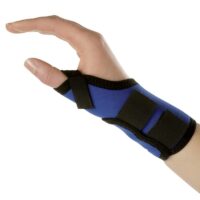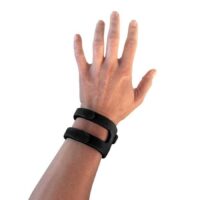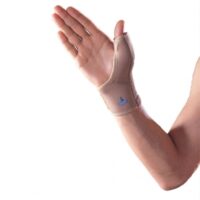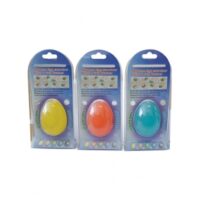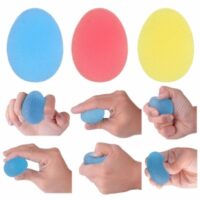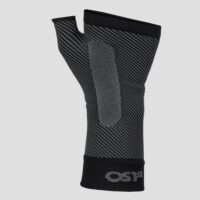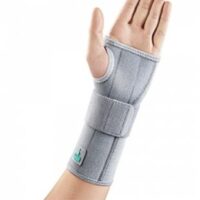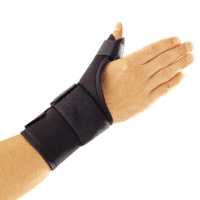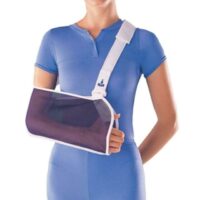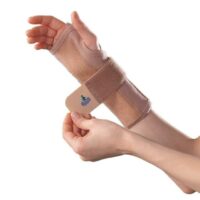Carpal Tunnel Syndrome (CTS)
Article by John Miller


Carpal Tunnel Syndrome
What is Carpal Tunnel Syndrome?
Carpal Tunnel Syndrome (CTS) is a common condition where the median nerve gets compressed at the wrist, leading to symptoms like numbness, tingling, and pain, often worsening at night. Repetitive hand movements, swelling from injuries, pregnancy, or arthritis can cause CTS. Physiotherapy offers non-invasive, effective treatments for CTS, focusing on alleviating symptoms and addressing the underlying causes.
The Anatomy of Your Carpal Tunnel
The carpal tunnel, a narrow passage in your wrist, houses the median nerve and tendons. It’s bordered by wrist bones and a ligament band. CTS symptoms emerge when this space narrows or its contents swell, increasing pressure on the nerve.

Causes Beyond the Wrist
CTS symptoms can also stem from nerve compression in other areas, such as a pinched nerve in the neck. This condition, known as “double crush syndrome,” underscores the importance of pinpointing the exact site of compression.
Neurodynamics’ Role
Nerves need to move freely along their paths. Obstructions, such as scar tissue or tight muscles, can disrupt this movement, causing CTS-like symptoms. Physiotherapists assess these neurodynamic factors to provide targeted treatment.
Hormonal and Occupational Influences
Hormonal changes, especially in middle-aged or pregnant women, can lead to CTS. Jobs involving repetitive wrist movements or vibrating tools also heighten the risk.
Recognising Symptoms
CTS manifests as pain, numbness, tingling, or burning in the hand and fingers. Symptoms often intensify at night, leading to muscle weakness and clumsiness in hand movements.
Diagnosing Carpal Tunnel Syndrome
Diagnosing CTS involves evaluating symptoms and conducting tests like Phalen’s or Tinel’s test. It’s crucial to examine the neck and upper back to rule out other causes. Nerve conduction studies or ultrasounds may be employed.
The Effectiveness of Physiotherapy in Carpal Tunnel Syndrome
Physiotherapy plays a pivotal role in the treatment of Carpal Tunnel Syndrome (CTS), as evidenced by a systematic review and meta-analysis conducted by Jiménez-Del-Barrio et al 2020. This study underscores the significance of manual therapy techniques, which include soft tissue and neurodynamic mobilisations.
These therapies have shown notable effectiveness in alleviating pain, improving physical function, and positively influencing nerve conduction studies in CTS patients. The focus on carpal bone mobilisation, nerve and tendon gliding exercises, and addressing cervical spine issues demonstrates a holistic approach to treatment, offering a comprehensive strategy for managing CTS symptoms.
The Role of Night Splints
Night splints play a crucial role in managing Carpal Tunnel Syndrome (CTS). These splints keep the wrist in a neutral position, reducing the pressure on the median nerve during sleep. This alleviation of pressure can significantly lessen the nocturnal symptoms of CTS, such as numbness, tingling, and pain.
Research on Night Splints & Hand Therapy
Recent studies have shown the effectiveness of night splints in CTS treatment. A study published in the Journal of Hand Therapy found that patients using night splints reported a substantial reduction in night-time symptoms. (Šošić et al 2020).
Practical Considerations
When using night splints, it’s essential to ensure they fit properly and maintain the wrist in a neutral position. They should be comfortable enough to wear all night without causing skin irritation or discomfort. It’s also important to note that while night splints are beneficial, they are most effective when used as part of a comprehensive treatment plan, including physiotherapy and ergonomic adjustments.
Night splints are a valuable tool in the management of Carpal Tunnel Syndrome, particularly in reducing night-time symptoms. They work best when combined with other treatments under the guidance of a physiotherapist. If you’re considering night splints for CTS, it’s advisable to consult a physiotherapist for a personalised treatment plan.
Kinesiology Tape in Carpal Tunnel Syndrome Treatment
Kinesiology tape is increasingly being used as an adjunct therapy for Carpal Tunnel Syndrome (CTS). This therapeutic tape is applied over and around the wrist to support and relieve pressure on the median nerve. The elastic properties of kinesiology tape gently lift the skin, enhancing circulation and reducing inflammation in the affected area. (Aktürk et al 2018)
It is typically used alongside other treatments such as physiotherapy exercises and ergonomic adjustments. As always, it’s advisable to consult a physiotherapist or healthcare professional for personalised advice and application techniques.
Surgical Considerations
Surgery is typically considered after conservative treatments like physiotherapy. It’s essential to confirm that CTS isn’t part of a “double crush syndrome” before opting for surgery.
Alternative Therapies
Ultrasound therapy, acupuncture, massage, and yoga may help in managing CTS. Ergonomic assessments in the workplace can help prevent recurrence.
Prognosis and Prevention
Early treatment offers a favourable prognosis for mild to moderate CTS. In chronic cases or those with muscle atrophy, surgery might be required. Preventative measures include ergonomic adjustments and regular physiotherapy check-ups.
Conclusion: Seek Professional Advice
Carpal Tunnel Syndrome can significantly affect daily activities. Understanding and accurate diagnosis are essential for effective treatment. If you’re experiencing CTS symptoms, consult a physiotherapist for a customised treatment plan. They can offer non-invasive options and guide you through the process, ensuring the best outcome for your condition.
Related Articles
- Common Causes of Wrist & Hand Pain: This article offers insights into various conditions that affect the wrist and hand, including CTS. It also discusses treatment options like physiotherapy modalities and ergonomics.
- Hand & Wrist Treatments: Here, you’ll find information on different treatment options for hand and wrist conditions. These include joint mobilisation techniques, muscle treatment like soft tissue massage, support and protection methods, and pain relief approaches such as acupuncture.
- Wrist Fracture Guide: Physiotherapy Tips: While focusing on wrist fractures, this guide also provides useful information on wrist supports and pain management techniques that could be applicable for CTS patients.
- Pinched Nerve: This article explains the condition of a pinched nerve, a common cause of symptoms similar to CTS, and offers valuable information on diagnosis and treatment.
- Neck Arm Pain: Since CTS can sometimes be related to issues in the neck and arm, this article provides useful information on how physiotherapy can help with arm symptoms, including those similar to CTS.
- Hand and Wrist Arthritis: This article discusses arthritis in the hand and wrist, which can be a factor in CTS. It covers mobility exercises, pain relief methods, and the role of physiotherapy in managing these conditions.
- Wrist Tendinopathy: Here, readers can learn about wrist tendinopathy, a condition that shares some symptoms with CTS. The article covers carpal bone mobilisation and nerve and tendon gliding exercises, which are also relevant for CTS.
- RSI – Repetitive Strain Injury: Since repetitive strain can lead to CTS, this article offers insights into understanding and managing RSI, which could be helpful for those looking to prevent CTS.
Article by John Miller
Common Wrist & Hand Pain or Injuries


Wrist and hand pain can significantly impact daily life, limiting your ability to perform simple tasks. In this article, we explore the common causes of wrist and hand pain, various injuries, and effective treatment options from a physiotherapist's perspective.
Traumatic Injuries
Traumatic injuries such as broken wrists, finger sprains, and thumb sprains are common causes of wrist and hand pain. These injuries often result from falls, accidents, or direct impacts. They cause immediate pain, swelling, and difficulty in moving the affected area.
Overuse Injuries
Overuse injuries occur due to repetitive motions or prolonged strain on the wrist and hand. Common overuse injuries include carpal tunnel syndrome, de Quervain’s tenosynovitis, and repetitive strain injury (RSI). These conditions often result in pain, numbness, and tingling sensations.
- Carpal Tunnel Syndrome
- de Quervain's Tenosynovitis
- Muscle Strain
- Overuse Injuries
- RSI - Repetitive Strain Injury
- Wrist Tendinopathy
Degenerative or Systemic Conditions
Conditions such as arthritis and rheumatoid arthritis can cause chronic wrist and hand pain. These conditions are typically progressive, leading to persistent pain, stiffness, and swelling in the joints.
Treatment Options for Wrist & Hand Pain
Physiotherapy offers a range of effective treatments for managing wrist and hand pain. Here are some common treatment approaches:
- General Management and Early Injury Treatment
Early intervention is crucial for managing wrist and hand injuries. Avoiding harmful activities, applying ice, and resting the affected area can prevent further damage. - Ergonomics
Proper ergonomics can reduce the risk of overuse injuries. An online workstation assessment can help identify and correct poor ergonomic practices that contribute to wrist and hand pain. - Joint Mobilisation Techniques
Physiotherapists use joint mobilisation techniques to improve joint movement and reduce pain. Physiotherapy instrument mobilisation (PIM) is a specialised technique that can effectively target stiff joints. - Muscle Treatment
Soft tissue massage and strength exercises can alleviate muscle tension and improve function. These treatments help restore normal movement patterns and reduce pain. - Support & Protection
Wrist braces, supportive taping, and kinesiology tape can provide stability to injured areas, preventing further strain and promoting healing. - Pain Relief Approaches
Acupuncture, dry needling, electrotherapy, and local modalities like heat packs and TENS machines can offer significant pain relief. These methods help manage pain and promote recovery.
Conclusion
Wrist and hand pain can stem from various causes, including traumatic injuries, overuse, and degenerative conditions. Effective management through physiotherapy can significantly improve your quality of life. Remember, early intervention and proper treatment are crucial in preventing long-term issues.
What to Do?
If you experience wrist and hand pain, seek the professional advice of your physiotherapist. They can provide a personalised treatment plan to address your specific needs and help you return to your daily activities pain-free.
Wrist & Hand Pain FAQs
- What are the common causes of wrist and hand pain? Wrist and hand pain can result from traumatic injuries, overuse conditions, and degenerative diseases like arthritis.
- How can carpal tunnel syndrome be treated? Carpal tunnel syndrome can be managed with physiotherapy, ergonomic adjustments, wrist braces, and sometimes surgical intervention.
- What are the symptoms of de Quervain’s tenosynovitis? Symptoms include pain and swelling near the base of the thumb, difficulty gripping, and a catching or snapping sensation when moving the thumb.
- How does physiotherapy help with wrist and hand pain? Physiotherapy offers treatments like joint mobilisation, muscle strengthening, and pain relief techniques to improve function and reduce pain.
- When should I see a physiotherapist for wrist and hand pain? If you experience persistent pain, swelling, or difficulty in movement, it is advisable to consult a physiotherapist for a proper assessment and treatment plan.
- Can ergonomic changes reduce wrist and hand pain? Yes, proper ergonomic practices can significantly reduce the risk of developing overuse injuries and alleviate existing pain.
Related Articles
- Ergonomics and Your Workstation
Discover how proper ergonomics can prevent wrist and hand pain. - Managing Carpal Tunnel Syndrome
Learn about effective treatments for carpal tunnel syndrome. - Understanding de Quervain’s Tenosynovitis
Find out the causes and treatments for de Quervain’s tenosynovitis. - Physiotherapy for Arthritis
Explore how physiotherapy can help manage arthritis pain. - Effective Use of Wrist Braces
Understand the benefits of wrist braces for support and pain relief. - The Role of Strength Exercises in Pain Management
Discover how strength exercises can alleviate wrist and hand pain. - Benefits of Acupuncture and Dry Needling
Learn how acupuncture and dry needling can provide pain relief. - Electrotherapy for Pain Management
Find out how electrotherapy can help manage wrist and hand pain. - Understanding Repetitive Strain Injury (RSI)
Get insights into the causes and treatments for RSI. - Joint Mobilisation Techniques in Physiotherapy
Learn about various joint mobilisation techniques used in physiotherapy.
Common Wrist & Hand Pain Treatments
General Management
- Early Injury Treatment
- Avoid the HARM Factors
- What to do after a Muscle Strain or Ligament Sprain?
- Sub-Acute Soft Tissue Injury Treatment
- Ergonomics
- Online Workstation Assessment









